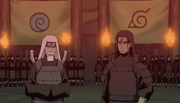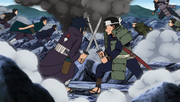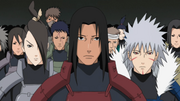LeafShinobi (talk | contribs) mNo edit summary Tag: sourceedit |
m (Per discussion) Tag: apiedit |
||
| (23 intermediate revisions by 13 users not shown) | |||
| Line 1: | Line 1: | ||
{{Infobox/Naruto/Clan |
{{Infobox/Naruto/Clan |
||
|image name=Senju Symbol.svg |
|image name=Senju Symbol.svg |
||
| − | |english=Senju clan |
||
|unnamed clan=No |
|unnamed clan=No |
||
|kanji=千手一族 |
|kanji=千手一族 |
||
|romaji=Senju Ichizoku |
|romaji=Senju Ichizoku |
||
| − | |literal=Senju clan |
||
|other={{translation|"''The clan with a thousand skills''"|「千の手を持つ一族」|"Sen no te o motsu ichizoku"}}<ref name="d3"/>, {{translation|Senju clan of the forest|森の千手一族|Mori no Senju Ichizoku}}<ref>Chapter 398, page 15</ref> |
|other={{translation|"''The clan with a thousand skills''"|「千の手を持つ一族」|"Sen no te o motsu ichizoku"}}<ref name="d3"/>, {{translation|Senju clan of the forest|森の千手一族|Mori no Senju Ichizoku}}<ref>Chapter 398, page 15</ref> |
||
|affiliations=Konohagakure |
|affiliations=Konohagakure |
||
| Line 11: | Line 9: | ||
|media=Anime, Manga, Game, Movie |
|media=Anime, Manga, Game, Movie |
||
}} |
}} |
||
| − | <section begin=summary />The {{translation|'''Senju clan'''|千手一族|Senju Ichizoku}} was |
+ | <section begin=summary />The {{translation|'''Senju clan'''|千手一族|Senju Ichizoku}} was one of the [[clan]]s responsible for founding [[Konohagakure]], the other being their rival [[Uchiha clan]]. Although the clan itself no longer appears to exist as a group, the Senju continue to influence Konoha's politics through their philosophy of the [[Will of Fire]] and the corresponding interpretation of the role of the [[Hokage]] position.<section end=summary /> |
| − | == |
+ | == History == |
| + | The Senju are descendants of [[Asura Ōtsutsuki]], the youngest son of the [[Sage of the Six Paths]]. Through Asura, the Senju inherited the Sage's "body", granting them a powerful life force and [[chakra]]. Unlike most other clans, the Senju never developed a trademark ability or style of combat, its members instead being equally proficient in all the ninja arts. It is from this balance that they acquired their name, {{translation|"Senju"|千手|lit meaning="a thousand skills", "a thousand hands"}}, in reference to their being {{translation|"the clan with a thousand skills"|「千の手を持つ一族」|"sen no te o motsu ichizoku"}}.<ref name="d3">''[[Sha no Sho]]'', "Shinobi Well-Informed Records"</ref> |
||
| − | [[File:Senju Clan.png|thumb|left|The Senju clan under Hashirama's leadership.]] |
||
| − | The Senju clan descended from [[Asura Ōtsutsuki]], the younger of the two sons of the [[Sage of the Six Paths]] who inherited the "body" of the Sage, his father's life force, stamina, physical energy, and believed that love was the key to bringing peace to the world. The Sage grew to favour Asura's ideals over those of [[Indra Ōtsutsuki]], his older son, who believed that power alone was the true key to finding peace. Therefore, on his deathbed it was Asura that the Sage chose to name as his successor. Indra, bitter and hateful at having being denied what he felt was rightfully his to inherit, attacked his younger sibling. The [[Uchiha clan]] would descend from Indra, resulting in the bitter centuries-long rivalry between the Senju and the Uchiha.<ref>Chapter 462, pages 12-13</ref> While undisputed, the Senju's legendary rivalry with Uchiha clan was taken advantage of by countries that hire their services. |
||
| + | [[File:Uzumaki-Senju clans.png|left|thumb|The Uzumaki and Senju clans.]] |
||
| − | The most famous member of the clan was [[Hashirama Senju]], whose unique [[Wood Release]] ninjutsu that gave the clan the nickname the {{translation|Senju clan of the forest|森の千手一族|Mori no Senju Ichizoku}}, and his ability to control the [[tailed beasts]], made him the greatest shinobi of his time. However, living in a world of constant bloodshed, Hashirama had a great love for his fellow man and a dream of peace among all ninja. Known as the {{translation|"''[[Will of Fire]]''"|火の意志|"Hi no Ishi"}}, this belief enabled Hashirama to use his position as leader to convince his clan to propose a truce with the Uchiha clan. Weary of fighting, and persuaded by Hashirama's great charisma and negotiation skill, though not accepted at first, the Uchiha ultimately conceded to the fact that the Senju were superior to them and started to surrender to the Senju. During a battle that lasted an entire day, Madara Uchiha finally fell in battle but still refused to accept the truce until Hashirama killed either himself or his own brother.<ref>Chapter 624</ref> Witnessing Hashirama's resolve to kill himself, Madara finally accepted their truce thus ending the bloody rivalry between the two clan.<ref>Chapter 625</ref> |
||
| + | The Senju are distant relatives of the [[Uzumaki clan]], and for that reason the two clans remained close allies throughout the years. Members at times married between clans, as with [[Hashirama Senju]] and [[Mito Uzumaki]],<ref name="ch500">Chapter 500, pages 3-4</ref> and the Uzumaki would provide [[fūinjutsu]] whenever the Senju needed one performed. More distantly, the Senju are also related to the [[Uchiha clan]], who descend from the Sage of Six Paths' other son, [[Indra Ōtsutsuki]]. Whereas Indra believed peace could be achieved through power, Asura believed peace could be achieved through love, a difference of mindset that caused them to battle over inheritance to the Sage's ways during their lifetimes. Their battle continued through the generations to their descendants, though neither the Senju nor the Uchiha remembered this reason for their conflict.<ref>Chapter 462, pages 12-13</ref> |
||
| − | [[File: |
+ | [[File:Hashirama VS Madara.png|thumb|The Uchiha vs. the Senju.]] |
| + | By the time of the [[Warring States Period]], the Senju and Uchiha had emerged as the strongest [[shinobi]] clans in the world. When one of the fledgling countries of the era would hire the Senju to fight in their wars, the opposing side would hire the Uchiha. The constant warfare between their clans only fueled their hatred, with all Senju owing the death of a loved one to an Uchiha and vice versa. But centuries of conflict began to wear on members of the clan; Hashirama Senju and [[Madara Uchiha]] met as children and became friends, bonding over their disapproval of the combat and death that they and their younger brothers were constantly subjected to and dreaming of a time when children wouldn't need to fight. Unable to do anything about the world at their age, Madara turned away from their dreams. |
||
| − | The Senju and the Uchiha created a permanent settlement for shinobi within the country: [[Konohagakure]]. The first of its kind, the system along with the name inspired more countries to have their own hidden village per country, ending the [[Warring States Period]] with Hashirama's dream becoming a reality. But it would soon start again after Hashirama was elected as the First [[Hokage]] with the only Uchiha who was against the truce, [[Madara Uchiha]] who came to the conclusion that the hope for his clan was slowly dwindling, defected from the village in search of what he called his own reality. This would renew his battles with Hashirama until the fated, final battle at the [[Valley of the End]] where Hashirama resolved to protect his own dream, killing his friend who had succumbed to the [[Curse of Hatred]].<ref>Chapter 626</ref> |
||
| − | [[File: |
+ | [[File:Senju Clan.png|thumb|left|The Senju clan under Hashirama's leadership.]] |
| + | Hashirama and Madara continued to face each other in battle over the coming years. In time, each became the leader of their respective clan, position that Hashirama tried to use to broker peace between them and finally achieve their childhood dreams. Despite growing interest in peace amongst the Uchiha, Madara was reluctant, opting instead to have one last contest for supremacy against the Senju.<ref>Chapter 624</ref> He was defeated, but rather than kill Madara, Hashirama offered to give up his own life if it would stop the fighting. Madara was moved by the gesture and agreed to peace. Their unified clans made a pact with the [[Land of Fire]] to create a [[hidden village]] within its borders, what would become [[Konohagakure]]. Other clans settled in Konoha to share their peace and Konoha's model was adopted across the shinobi world.<ref>Chapter 625</ref> |
||
| − | The Senju and [[Uzumaki]] clans are distant blood relatives whom they retained strong connections with.<ref>Chapter 500, page 3</ref> For this reason Konoha-nin uniforms have the symbol of Uzushiogakure emblazoned on its shoulders.<ref>Chapter 500, page 3</ref> Hashirama's [[Mito Uzumaki|wife]] would also come from this clan, further strengthening their ties.<ref>Chapter 500, page 4</ref> Throughout the years, the Senju retained their supremacy over Konoha, and made the village into what it is today. After the First Hokage's death, his younger brother, [[Tobirama Senju]], stepped up to become the Second Hokage. Although likely not a Senju by blood, [[Hiruzen Sarutobi]], who would become the Third Hokage after the Second's death, was trained by both the First and Second. His successor, [[Minato Namikaze]], was the student of [[Jiraiya]], who was a student of the Third. [[Tsunade]], the Fifth Hokage, was not only a student of the Third, but also the granddaughter of the First and the grandniece of the Second. All of them strongly held to the [[Will of Fire]] philosophy. |
||
| − | |||
| ⚫ | It |
||
| + | The villagers of Konoha selected Hashirama to be their First [[Hokage]], Konoha's leader. Madara interpreted this as the first step in the Senju's supremacy over the Uchiha, and for that reason left the village in protest. Hashirama had no intention of the Senju being left in charge and in fact believed it would be best if all Konoha's villagers, the Senju and Uchiha included, focused on Konoha's interests rather than their clan's.<ref>Chapter 626</ref> Despite this, Madara's fears would end up coming true: Hashirama's brother became the [[Second Hokage]], his grandaughter becomes the [[Fifth Hokage]], and all other Hokage have been part of a tree of student–teacher relationships that trace back to Hashirama. |
||
| − | == Abilities == |
||
| − | As descendants of the [[Ōtsutsuki Clan]], the Senju Clan were gifted with tremendously strong chakra and chakra reserves having inherited [[Hagoromo Ōtsutsuki]]'s "body". As such they could fight for hours without suffering chakra exhaustion or even longer as [[Hashirama]] and [[Tobirama]] have demonstrated. Also unlike other Ninja Clans which specialise in one skill, the Senju were prodigious in all skills, from [[ninjutsu]], [[taijutsu]], and [[genjutsu]] so they were extremely well rounded, they were known as {{translation|"''the clan with a thousand skills''"|「千の手を持つ一族」|"sen no te o motsu ichizoku"}}, which gave them their name {{translation|"Senju"|千手|lit meaning="a thousand skills", "a thousand hands"}}.<ref name="d3">Third Databook — ''Shinobi Well-Informed Records''</ref> |
||
| ⚫ | It isn't clear if the Senju still formally exist as a clan, as no living Konoha villagers are known to still bear the name. ''[[Konoha Hiden]]'' suggests that they are no longer active, as [[Kiba Inuzuka]] only recognises the name from history classes. Despite this, the Senju's influence continues to live on in all of Konoha's inhabitants, chiefly because of the Senju's [[Will of Fire]]: that Konoha is a family that must be protected at all costs. |
||
| − | Unique to [[Hashirama Senju]], the clan also had the [[Wood Release]] [[Kekkei Genkai]] which could [[Tailed Beast Control|suppress and control]] the [[Tailed Beasts]].<ref>Chapter 626, page 8</ref> |
||
== Trivia == |
== Trivia == |
||
| ⚫ | |||
| − | * The name "Senju" literally means {{translation|"thousand hands"|千手}}, possibly referring to the clan being called ''"The clan with a thousand skills"''. |
||
| ⚫ | |||
| ⚫ | |||
| ⚫ | |||
* The clan's symbol resembles a [[wikipedia:Vajra|Vajra]], both a symbol and a ritual object present in Buddhism and Hinduism. As a symbol, it represents both indestructible and irresistible force. |
* The clan's symbol resembles a [[wikipedia:Vajra|Vajra]], both a symbol and a ritual object present in Buddhism and Hinduism. As a symbol, it represents both indestructible and irresistible force. |
||
| − | *Before settling in Konohagakure, the Senju clan resided on a remote keep surrounded by a forest.<ref name="NS368">''Naruto: Shippūden'' episode 368</ref> |
||
| − | * The Senju, pre-Konoha, all had a common means of dress which consisted of light-coloured pin-stripped high-waist pants, kimono shirts over which they wore long-sleeved haori with their clan's symbol emblazoned on the back.<ref>Chapter 625, page 5</ref> In battle, they wore the heavy armour typical of the era, with the Senju symbol on the shoulder platings near the neck and on their headbands. In addition, they wore fish net armour underneath their clothing and armour for additional protection. |
||
== References == |
== References == |
||
Revision as of 11:14, 30 January 2016
| Senju Clan | |||
|---|---|---|---|
 | |||
| (千手一族, Senju Ichizoku)
| |||
| Debut | |||
| Appears in | Anime, Manga, Game, Movie | ||
| Clan Data | |||
| Affiliation | |||
| Kekkei Genkai | |||
| |||
| |||
The Senju clan (千手一族, Senju Ichizoku) was one of the clans responsible for founding Konohagakure, the other being their rival Uchiha clan. Although the clan itself no longer appears to exist as a group, the Senju continue to influence Konoha's politics through their philosophy of the Will of Fire and the corresponding interpretation of the role of the Hokage position.
History
The Senju are descendants of Asura Ōtsutsuki, the youngest son of the Sage of the Six Paths. Through Asura, the Senju inherited the Sage's "body", granting them a powerful life force and chakra. Unlike most other clans, the Senju never developed a trademark ability or style of combat, its members instead being equally proficient in all the ninja arts. It is from this balance that they acquired their name, "Senju" (千手, literally meaning: "a thousand skills", "a thousand hands"), in reference to their being "the clan with a thousand skills" (「千の手を持つ一族」, "sen no te o motsu ichizoku").[1]

The Uzumaki and Senju clans.
The Senju are distant relatives of the Uzumaki clan, and for that reason the two clans remained close allies throughout the years. Members at times married between clans, as with Hashirama Senju and Mito Uzumaki,[3] and the Uzumaki would provide fūinjutsu whenever the Senju needed one performed. More distantly, the Senju are also related to the Uchiha clan, who descend from the Sage of Six Paths' other son, Indra Ōtsutsuki. Whereas Indra believed peace could be achieved through power, Asura believed peace could be achieved through love, a difference of mindset that caused them to battle over inheritance to the Sage's ways during their lifetimes. Their battle continued through the generations to their descendants, though neither the Senju nor the Uchiha remembered this reason for their conflict.[4]

The Uchiha vs. the Senju.
By the time of the Warring States Period, the Senju and Uchiha had emerged as the strongest shinobi clans in the world. When one of the fledgling countries of the era would hire the Senju to fight in their wars, the opposing side would hire the Uchiha. The constant warfare between their clans only fueled their hatred, with all Senju owing the death of a loved one to an Uchiha and vice versa. But centuries of conflict began to wear on members of the clan; Hashirama Senju and Madara Uchiha met as children and became friends, bonding over their disapproval of the combat and death that they and their younger brothers were constantly subjected to and dreaming of a time when children wouldn't need to fight. Unable to do anything about the world at their age, Madara turned away from their dreams.

The Senju clan under Hashirama's leadership.
Hashirama and Madara continued to face each other in battle over the coming years. In time, each became the leader of their respective clan, position that Hashirama tried to use to broker peace between them and finally achieve their childhood dreams. Despite growing interest in peace amongst the Uchiha, Madara was reluctant, opting instead to have one last contest for supremacy against the Senju.[5] He was defeated, but rather than kill Madara, Hashirama offered to give up his own life if it would stop the fighting. Madara was moved by the gesture and agreed to peace. Their unified clans made a pact with the Land of Fire to create a hidden village within its borders, what would become Konohagakure. Other clans settled in Konoha to share their peace and Konoha's model was adopted across the shinobi world.[6]
The villagers of Konoha selected Hashirama to be their First Hokage, Konoha's leader. Madara interpreted this as the first step in the Senju's supremacy over the Uchiha, and for that reason left the village in protest. Hashirama had no intention of the Senju being left in charge and in fact believed it would be best if all Konoha's villagers, the Senju and Uchiha included, focused on Konoha's interests rather than their clan's.[7] Despite this, Madara's fears would end up coming true: Hashirama's brother became the Second Hokage, his grandaughter becomes the Fifth Hokage, and all other Hokage have been part of a tree of student–teacher relationships that trace back to Hashirama.
It isn't clear if the Senju still formally exist as a clan, as no living Konoha villagers are known to still bear the name. Konoha Hiden suggests that they are no longer active, as Kiba Inuzuka only recognises the name from history classes. Despite this, the Senju's influence continues to live on in all of Konoha's inhabitants, chiefly because of the Senju's Will of Fire: that Konoha is a family that must be protected at all costs.
Trivia
- All known pre-Konoha male Senju's name end in "-ma" (ま), more commonly written using the kanji "間", which can refer to space or a room.
- Although they owe part of their fame as the "Senju clan of the forest" (森の千手一族, Mori no Senju Ichizoku) to the Wood Release, Hashirama Senju was the only clan member known to be able to use it.
- The clan's symbol resembles a Vajra, both a symbol and a ritual object present in Buddhism and Hinduism. As a symbol, it represents both indestructible and irresistible force.

